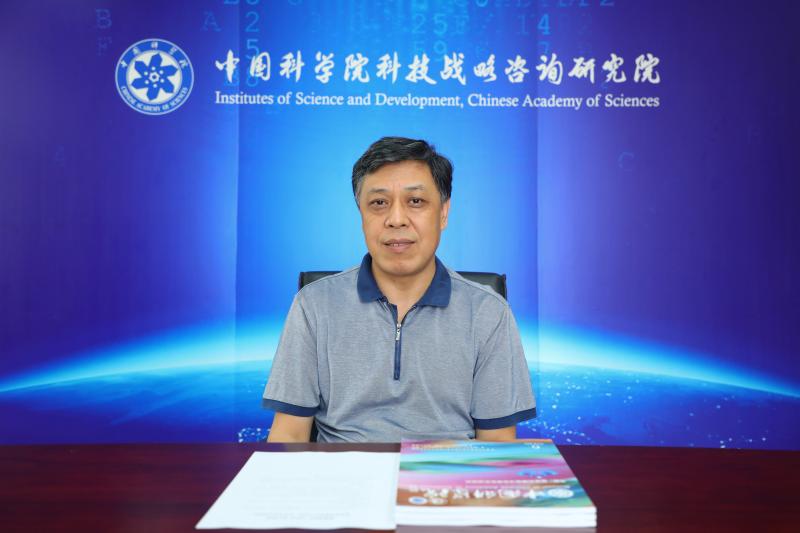Chinese expert: New methodology lays groundwork for high-quality think tank development
 0 Comment(s)
0 Comment(s) Print
Print E-mail China.org.cn/Chinagate.cn, November 25, 2022
E-mail China.org.cn/Chinagate.cn, November 25, 2022
This fall, “Bulletin of Chinese Academy of Sciences” (BCAS, in Chinese) journal discussed the status of Chinese think tanks and a new approach to think tank research known as double helix methodology in an exclusive interview with Professor Pan Jiaofeng, president of the Institutes of Science and Development, Chinese Academy of Sciences (CASISD).

Professor Pan Jiaofeng, president of the Institutes of Science and Development, Chinese Academy of Sciences (CASISD).
“The establishment of new think tanks with Chinese characteristics does not have a long history,” Pan noted. “We have needed to push forward with methodology innovation in order to promote the evolution from specialization to scientification with regard to their development trajectory.”
Think tanks have been emerging rapidly in China in the last decade and have been entering a new stage of growth in recent years. The number of specialized think tanks in China currently ranks among the top in the world, and its pool of full-time researchers and specialized research teams continues to expand.
“There is urgent demand for think tanks to serve as bridges, links, and networks that help foresee global development trends, address major challenges faced by all of humanity, and build a community with a shared future for mankind,” Pan commented after observing that the world is undergoing profound changes unseen in a century.
“Many think tanks have been facing major urgent challenges, however, mostly due to a lack of understanding of the essence of think tank research and an absence of a system of theory,” he stated. “Valuing research techniques designed to help solve specific problems and enhance scientificity, more and more well-known think tanks in the world have developed a variety of innovative quantitative and qualitative methods.”
“Think tanks are more highly valued, have been playing an increasingly important role in Chinese society, and have entered a new stage of high-quality development [in recent years],” Pan continued.
The CASISD president mentioned that the new approaches that have emerged in recent years, such as the double helix methodology that he and his team first proposed in 2020, have made it possible “to unravel think tank problems and for think tanks to better engage in scientification and advance towards disciplinization amidst the formation of think tank science and engineering.”
Like a strand of DNA, the double helix methodological system put forth by Pan’s team features two main interconnected components – an integrated model concerned with data, information, intelligence, and solutions (DIIS) and one covering mechanisms, impact, policy and solutions (MIPS). The model includes an internal process consisting of the interaction between DIIS and MIPS and an external process comprising decomposition, fusion and restoration.
“Interdisciplinarity, interconnectedness, innovation, uncertainty, policy practicability, and social impact are six key aspects of the evolution of think tanks and their research,” he emphasized. “They are typical convergence problems and are related to our original reasons for developing double helix methodology.”
The trailblazer stated that he and his team have participated in pilot construction of high-end Chinese think tanks that utilize double helix methodology and that they formulated more-in-depth problem-, evidence-, and science-oriented DIIS methodology in order to address think tank problems after summarizing the experience that was gained and abstracting essential standardized research processes.
Published in 2021, the English version of Pan’s book “DIIS Theory and Methodology in Think Tanks” elaborates on the DIIS aspect of the framework, explaining that it aims to improve the scientificity, efficacy, and reliability of think tank research results, facilitate systematic theoretical analysis, and promote think tank development.
“To put it simply, consisting of a four-part research paradigm that can be used by think tanks comprised of an external process, an internal process, 10 key issues, and methods and tools for addressing them, double helix methodology starts with the study of a problem and ends with solutions,” he summarized. “Such a complete methodology makes it possible to integrate scientificity into the orientation, philosophy, process, and logic of think tank research.”
“The 10 key issues are decomposition of the think tank problem, the scenario analysis driven by think tank problem, the uncertainty analysis of think tank problem research, the policy simulation analysis of think tank problem research, the circulative iteration of think tank research, the coupling relationship between DIIS and MIPS, the expert organization and management of think tank research, the human-machine combination think tank research support system, the combination of objective analysis and subjective judgment, and the think tank product quality management,” Pan added.
“Constituting a complete knowledge system integrating knowledge and action and social and natural sciences and advancing with the times, the mature research tools and methods that we have developed have endowed CASISD with unique competitive advantages,” he elaborated. “The tools and methods will enable think tanks to help modernize the national governance system and enhance governance capacity and will become an indispensable force serving the progress of human civilization. Looking forward, think tank science and engineering should pursue and refine appropriate tools and research methods and theory and ideology and adapt to various application scenarios and research areas.”
Pan concluded: “We have paid special attention to social phenomena associated with issues in the real world in order to achieve the integration of theory and practice when conducting research. We should also strengthen international cooperation and exchange with regard to think tank research so as to jointly put forward solutions that promote the development of the world, overall prosperity, and the progress of civilization.”


